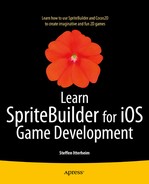Introduction
After I updated my previous book, Learn cocos2d 2 to its 3rd edition (published late 2012), I had absolutely no intention of writing another technical book. Certainly not one about Cocos2D.
For one, writing a book is a lot of work and that makes it even more painful to see it go out of date even before it is published. This fate is shared by many technical books.
On the other hand, Cocos2D in its 2.x version was fairly stable. It also didn’t seem to have gone anywhere. It was merely being maintained at the time, with new features being developed not in the best interest of the community, but instead in the best interest of the company that had, at the time, internalized the development of the open source project Cocos2D.
In fall 2013, Apple released iOS 7. With it came Sprite Kit, a 2D rendering engine very similar to Cocos2D at the time. Interest in Cocos2D waned rapidly.
It was at that time that Apportable took to Cocos2D. It hired developers from the community to work on Cocos2D to improve it and, ultimately, to make it better than Sprite Kit in every regard. And so work on the 3.x branch began.
At the same time, SpriteBuilder was to become not just one of many but the visual editor for Cocos2D. It was well integrated, without quirky setup steps, and there was no having to wait for it to catch up to support newer Cocos2D versions.
Over the course of 2014, SpriteBuilder and Cocos2D became one. And exciting new features were added: a fully integrated Objective-C version of the Chipmunk physics engine, a new renderer API that transparently supports both OpenGL and Metal, and built-in shader effects without having to write any shader code.
Cocos2D is now more alive and vibrant like never before.
When Apportable came to me with the idea for a book on SpriteBuilder and Cocos2D, it didn’t take long for me to accept the challenge. Too much had changed that I didn’t want to leave undocumented, and I was excited that SpriteBuilder and Cocos2D might become what I always hoped they would become.
Knowing what goes out of date most quickly, I was confident that I could avoid most of the pitfalls of technology becoming outdated in order to keep the book valid and applicable for a longer time. The fact that the book revolves mostly around SpriteBuilder will certainly help in that regard, as did writing the book against the very latest development branches. As I write these lines, it’s early November 2014 and SpriteBuilder v1.3, which this book covers, has just been submitted to the Mac App Store for review.
My next project will have me updating the SpriteBuilder and Cocos2D online documentation. It is intended to be a reference manual that goes well with this book. I will do my best to point out anything that may have changed significantly since the book was published.
You will find this documentation online at http://www.cocos2d-swift.org/docs. The first version will cover SpriteBuilder v1.3 and Cocos2D v3.3. I recommend that you keep this link open in a browser tab while reading through this book.
Personally, I’m glad that I can recover from writing now by…writing more documentation. Online documentation is a different format with different requirements and possibilities, and I look forward to updating and improving that side of things, too.
I also very much look forward to getting your feedback on the SpriteBuilder (http://forum.spritebuilder.com) and Cocos2D (http://forum.cocos2d-swift.org) forums so that I can integrate that feedback in the online documentation.
And who knows, perhaps after another period of never wanting to write another book again I’ll get back to making revisions to this book. I’m starting to think that technical writing is, in fact, dangerously addictive.
In any case, I hope you will enjoy reading this book as much as I enjoyed getting high on writing it.
